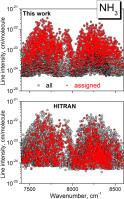在7400 ~ 8600 cm-1之间重测了氨吸收光谱
IF 1.9
3区 物理与天体物理
Q2 OPTICS
Journal of Quantitative Spectroscopy & Radiative Transfer
Pub Date : 2025-08-19
DOI:10.1016/j.jqsrt.2025.109639
引用次数: 0
摘要
在布鲁塞尔自由大学记录的傅立叶变换吸收光谱的基础上,在7400和8600 cm-1之间重新审视了氨的室温吸收光谱。检索到的经验线列表大约有8400多条线,并且大大扩展了从同一光谱检索到的先前列表,并在所考虑的区域中用作HITRAN数据库中线参数的主要来源。通过与变分线列表(Coles等人的C2018列表)进行比较。[J] .地球物理学报,2018;19(1):1 - 4。10.1016/j.j jqsrt.2018.07.022),并使用低状态组合差分关系(LSCD)验证大部分赋值,大约分配了2798个转换。它们属于60个波段,约占该区域强度总和的72%。Barton et al. (J Mol Spectrosc 2016; 325:7-12)先前的作业。10.1016/j.jms.2016.05.001),在HITRAN数据库中复制的结果与目前的结果不一致。提供了一组1149个上态能级经验值,典型精度为10-3 cm-1。本文章由计算机程序翻译,如有差异,请以英文原文为准。

The ammonia absorption spectrum revisited between 7400 and 8600 cm-1
The room temperature absorption spectrum of ammonia is revisited between 7400 and 8600 cm-1 on the basis of a Fourier transform absorption spectrum recorded at Université Libre de Bruxelles. The retrieved empirical line list counts more than 8400 lines and extends significantly a previous list retrieved from the same spectrum and used as main source of line parameters in the HITRAN database, in the considered region. By comparison with a variational line list, the C2018 list from Coles et al. (J Quant Spectrosc Radiat Transf 2018;219:199–212. 10.1016/j.jqsrt.2018.07.022), and validating most of the assignments by using lower state combination difference relations (LSCD), about 2798 transitions are assigned. They belong to 60 bands and correspond to about 72 % of the intensity sum in the region. The previous assignments by Barton et al. (J Mol Spectrosc 2016;325:7–12. 10.1016/j.jms.2016.05.001) which are reproduced in the HITRAN database show a poor agreement with the present results. A set of 1149 empirical values of the upper state energy levels is provided with a typical accuracy of 10–3 cm-1.
求助全文
通过发布文献求助,成功后即可免费获取论文全文。
去求助
来源期刊
CiteScore
5.30
自引率
21.70%
发文量
273
审稿时长
58 days
期刊介绍:
Papers with the following subject areas are suitable for publication in the Journal of Quantitative Spectroscopy and Radiative Transfer:
- Theoretical and experimental aspects of the spectra of atoms, molecules, ions, and plasmas.
- Spectral lineshape studies including models and computational algorithms.
- Atmospheric spectroscopy.
- Theoretical and experimental aspects of light scattering.
- Application of light scattering in particle characterization and remote sensing.
- Application of light scattering in biological sciences and medicine.
- Radiative transfer in absorbing, emitting, and scattering media.
- Radiative transfer in stochastic media.

 求助内容:
求助内容: 应助结果提醒方式:
应助结果提醒方式:


